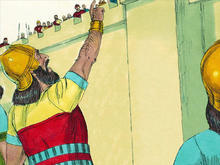Sieges
By Mark Morgan | Jeremiah

Nations come and nations go. Empires rise and empires fall. Cities blossom and flourish, then moulder into dust.
When a nation has a leader with grand ideas and a strong desire for power, its neighbours must pay heed to their defences. Armies swell and walls are built or strengthened to protect important cities. Watchers are placed at borders and leaders must decide what defensive action is best.
Then the attacking armies come. They always do. Battles can be fought at borders or in the open country, or the defenders may wait until their cities are surrounded and besieged.
Historically, walls were built around cities to keep out attackers, and the Bible often speaks of the sieges that resulted when armies attacked. Unwalled villages were all too easily overrun, and the land pillaged, but – particularly before the invention of gunpowder – walled cities were much stronger and safer.
Kingdoms are all about power and wealth. Power gives leaders control over others, and wealth provides comfort. The endless struggle for power and wealth fills the history books and is played out in our media every day.
Effective leaders achieve their dreams of domination by convincing others to help them on the basis that they will share in the power and wealth that can be won.
Aggressive armies seek golden treasures,[1] which is why boasting about your wealth is never a good idea. After miraculously recovering from a near-fatal sickness, Hezekiah, king of Judah, received a visit from representatives of Babylon, at which time he showed them all of his splendour and his treasures.[2] A little over 100 years later, the Babylonians were back, but this time they came to help themselves to some of the treasures that Hezekiah had shown them – as Isaiah the prophet had predicted to him.[3] As Solomon said:
“Pride goes before destruction, and a haughty spirit before a fall.”
Proverbs 16:18
Nebuchadnezzar the king of Babylon returned on two other occasions over the following nineteen years, and by the end of that time, there were no more treasures to take, nor even a city to be defended.
According to Wikipedia, Jerusalem has been attacked 52 times and besieged 23 times. Another author suggests that it has been the subject of at least 118 conflicts.[4]
Jerusalem has been a city of conflict for thousands of years – ironic, isn’t it, given that Jerusalem means “city of peace”?
Our article is planned in two parts: this first part looking at sieges in general; the second part dealing with the final siege of Jerusalem by Nebuchadnezzar, which culminated in the destruction of the city and the end of the kingdom of Judah.
Let’s begin by looking at how a siege worked in those days.
Imagine that an army attacked another country for any of the reasons that are still common today – revenge, greed, helping a third party, imperialism, a feeling of cultural superiority, etc. – the reason doesn’t really matter all that much. If the country being attacked could not or would not fight, many of its people would have fled to fortified cities, places developed carefully to make sure that they were easy to defend and hard to attack.
Everyone crowded inside the walls and the city gates were shut against the attacking army. For people who already lived inside the city, it made sense to stay. For those who lived elsewhere, the decision had been made to seek safety in numbers within a city. Stone walls seemed to offer more protection from a ravaging army than a waving field of wheat.
Generally, an attacking army did whatever it could to defeat the city it was besieging. However, God had put some constraints on his people when they were besieging a city: they were not allowed to cut down fruit trees to provide wood that could be used in the siege.
“When you besiege a city for a long time, making war against it in order to take it, you shall not destroy its trees by wielding an axe against them. You may eat from them, but you shall not cut them down. Are the trees in the field human, that they should be besieged by you? Only the trees that you know are not trees for food you may destroy and cut down, that you may build siegeworks against the city that makes war with you, until it falls.”
Deuteronomy 20:19-20
But the nations attacking Israelite cities recognised no such constraints.
In the Bible we read of the following methods being used when besieging cities:
The people in the city do whatever they can to stop the attackers from entering the city.
Preparation to achieve this included:
And when the city was under siege, what did the defenders do?
Sieges could last a long time. Assyria besieged Samaria for 3 years before conquering it (2 Kings 17:5-6). In the time of King Ahaz of Judah, the kings of Syria and Israel were working together to besiege Jerusalem, but had to give up in the end (2 Kings 16:5). Nebuchadnezzar besieged Jerusalem for 18 months before finally making a significant breach in the walls and achieving victory.
Within the city, famine and disease can result from a protracted siege (Jeremiah 32:24). Examples of extreme hardship in two different sieges are:
Notes